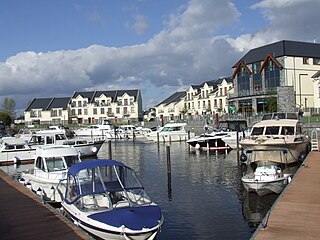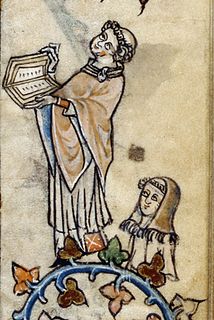Bibliography
- Music and musicians in medieval Irish society, Ann Buckley, pp. 165–190, Early Music xxviii, no.2, May 2000
- Music in Prehistoric and Medieval Ireland, Ann Buckley, pp. 744–813, in A New History of Ireland, volume one, Oxford, 2005.
Mael Sechlainn Mac Carmaic, Irish musician, died 1330.
Mael Sechlainn is called a brughaidh in the Irish language originals of several contemporary annals, [1] [2] [3] which has been variously translated as general entertainer or rich and prosperous yeoman in English language editions. [4] [5] The word brughaidh itself occurs in later medieval texts, but it is used more clearly to define a rank in society than a responsibility for public hospitality. Passages in the Book of Fenagh name the brughaidh as next in rank to the taoiseach. [6]
Thus his exact profession is uncertain, but he is notable as one of the very few professional people who were thought worthy enough to be mentioned in the extant Gaelic–Irish annals.
There was a branch of the O'Donnell dynasty named Mac Carmaic, apparently pre-dating the reign of Donnell Óg O'Donnell (d. 1281), several of whom became Bishop of Raphoe. Their earliest known ancestor was known only by the title "Fear léinn", variously translated as scholar or lector [7] [8] Descendants of this branch may have survived at least into the mid-17th century in the parishes of Clonleigh and Donaghmore, County Donegal. [9]
Year 539 (DXXXIX) was a common year starting on Saturday of the Julian calendar. At the time, it was known as the Year of the Consulship of Strategius without colleague. The denomination 539 for this year has been used since the early medieval period, when the Anno Domini calendar era became the prevalent method in Europe for naming years.

Ballinamore is a small town in County Leitrim, Ireland.

The Annals of the Kingdom of Ireland or the Annals of the Four Masters are chronicles of medieval Irish history. The entries span from the Deluge, dated as 2,242 years after creation to AD 1616.
Cormac mac Art Ó Melaghlain, was King of Mide from around 1209/10 to 1239. He managed to win several notable victories over the Anglo-Normans and as a result was one of the more prominent and successful later Kings of Mide. Whatever gains Cormac made were not to prove long lasting however, even in his own reign, and the successor lords of Clann Cholmain were largely insignificant to the politics of later medieval Ireland.

Leitrim is a village in County Leitrim, Ireland, on the River Shannon near the border with County Roscommon. It is at the junction of the R280 and R284 regional roads.
A number of Irish annals, of which the earliest was the Chronicle of Ireland, were compiled up to and shortly after the end of the 17th century.
Dubsúilech Ó Maolconaire was a member of the Ó Maolconaire family of Connacht, who served as historians and poets to the Síol Muireadaigh and their rulers, the Ó Conchubhair Kings of Connacht.
Cathal mac Conchobair was King of Connacht.
Auisle or Óisle was a Viking leader in Ireland and Scotland in the mid-late ninth century. He was the son of the king of Lochlann, identified in the non-contemporary Fragmentary Annals of Ireland as Gofraid, and brother of Amlaíb Conung and Ímar, the latter of whom founded the Uí Ímair dynasty, and whose descendants would go on to dominate the Irish Sea region for several centuries. Another Viking leader, Halfdan Ragnarsson, is sometimes considered a brother. The Irish Annals title Auisle, Ímar and Amlaíb "kings of the foreigners". Modern scholars use the title "kings of Dublin" after the Viking settlement which formed the base of their power.
Conchobar mac Taidg Mór was a King of Connacht from the Uí Briúin branch of the Connachta. He was the grandson of Muirgius mac Tommaltaig, a previous king. His father Tadg Mór had been slain fighting in Muirgius' wars versus the minor tribes of Connacht. He was of the Síl Muiredaig sept of the Uí Briúin. The Ó Conchobhair septs of Connacht are named for him.
Cú Cherca mac Fáeláin was a King of Osraige in modern County Kilkenny. He was the son of Fáelán mac Crundmaíl, a previous king. The dynasty that ruled over Osraige in the early Christian period was known as the Dál Birn. He ruled from 693 to 712. The Irish annals mention only his death. His son Anmchad mac Con Cherca was also King of Osraige.
Fáelchar Ua Máele Ódrain or Fáelchar mac Forandla was a King of Osraige in modern County Kilkenny.
Tadg mac Conchobair was a King of Connacht from the Uí Briúin branch of the Connachta. He was the son of Conchobar mac Taidg Mór, a previous king, the second of his three sons to rule in succession, succeeding his brother Áed mac Conchobair. He was of the Síl Muiredaig sept of the Uí Briúin. He ruled from 888-900.
Murchad mac Áedo was a King of Connacht from the Uí Briúin branch of the Connachta. He reigned from 839-840.
Manchán of Min Droichit was an Irish scholar and Abbot.
The Kings of Ui Fiachrach Muaidhe were the northern branch of Ui Fiachrach, based on the plain of the Muaidhe.
Énna Mac Murchada, or Enna Mac Murchada, also known as Énna mac Donnchada, and Énna mac Donnchada mic Murchada, was a twelfth-century ruler of Uí Chennselaig, Leinster, and Dublin. Énna was a member of the Meic Murchada, a branch of the Uí Chennselaig dynasty that came to power in Leinster in the person of his paternal great-grandfather. Énna himself gained power following the death of his cousin Diarmait mac Énna. Throughout much of his reign, Énna acknowledged the overlordship of Toirdelbach Ua Conchobair, King of Connacht, although he participated in a failed revolt against the latter in 1124 before making amends. When Énna died in 1126, Toirdelbach successfully took advantage of the resulting power vacuum.
Dúngal mac Fergaile was king of Osraige from 802 until his death in 842.

Saint Maonacan, otherwise Manchanof Athleague, was an early Irish Christian saint. He founded a church in Athleague, in county Roscommon. Saint Manchan's feast day is celebrated on February 18, by Roman Catholics, and Anglicans. The life of Manchan of Athleague is obscured because many persons named Manchan are to be found among the monastically-inclined medieval Irish Christians.
In 6th century Ireland, the population of Mohill was devastated by the Justinian plague, an early phenomenon of the Late Antique Little Ice Agec. 536–660 AD. The Mohill plague occurred following the Extreme weather events of 535–536 and death of Manchán of Mohill.